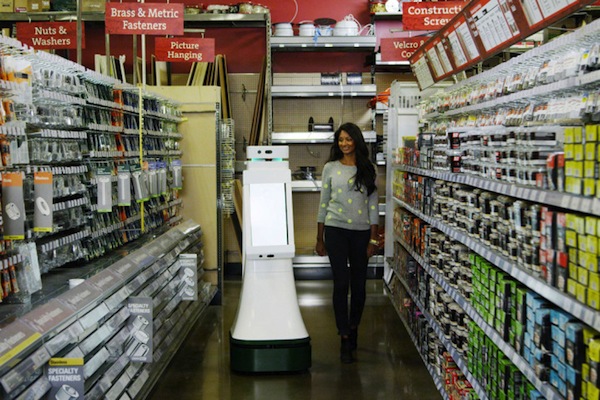A couple of Oxford University researchers predicted in 2013 that nearly half of American jobs could be automated within 20 years.
Such a fundamental transformation to the workplace suggests a severe reduction in immigration would be wise, but the Masters of the Universe in Washington seem unconscious to the worsening problem of technological unemployment. The arguments one hears about joblessness are the same old positions: the left demands a higher minimum wage (which causes employers to switch more rapidly to automation) and the right argues that less government regulation will expand employment, which is likely true to a degree. Meanwhile, 93 million Americans are not working and labor participation is at a record low level, so it’s reasonable to think the jobs universe has shrunk at least partially because of automation. And mass immigration continues on auto-pilot.
Below, the OSH robot has been introduced by Orchard Supply Hardware to guide customers to items of interest.

Interestingly, a 2013 article about that year’s Gartner forecast was titled: As the digital revolution kills jobs, social unrest will rise (Computerworld.com, Oct 7, 2013). Certainly, a jobless future portends worsened economic dislocation, as other automation experts have warned. Martin Ford, the author of Rise of the Robots: Technology and the Threat of a Jobless Future has emphasized that smart machines will rock the foundations of our economic system.
Surely America shouldn’t continue importing millions of unskilled third-worlders when there will be no jobs for them, even given their extremely low wage cost.
For example, bricklaying is a low-skilled job that can now be done by machine:
The Gartner company recently came out with its annual top ten list of predictions of important trends in the tech industry and by extension, the world we inhabit.
Robotics, automation play a big role in Gartner’s top 10 predictions, by Patrick Thibodeau, Computerworld.com, October 6, 2015Machines will replace more writers, and by 2018, 2 million workers will be required to wear health monitors
ORLANDO — Chances are robots aren’t mowing your yard, teaching your children, or bossing you around at work – yet.
But according to Gartner’s annual top-10 list of strategic predictions, robots, robotic systems and automation will have an expanding role.
Sooner or later, there will be robots that train your children and help them with their homework. That “might seem a little strange to us, but is it really stranger than being trained by a purple dinosaur named Barney?” said Daryl Plummer, a Gartner analyst, to the laughter of his audience at the research firm’s Symposium ITxpo.
Here are Gartner’s predictions:
1. Writers will be replaced. By 2018, 20% of all business content, one in five of the documents you read, will be authored by a machine, Plummer said.
“Robowriters” are already producing budget reports, sports and business reports, and this trend is sneaking in without notice. One advantage for machines: They don’t have biases or emotional responses, he said.
2. By 2018, 6 billion connected things will be requesting support. These non-human “things” are nonetheless customers requesting services and data, and other methods of support. Marketing to them (and by extension their human owners) can help build a business.
3. By 2020, autonomous software agents outside of human control will participate in 5% of all economic transactions. Smart algorithms are already beginning to perform transactions without our help.
4. By 2018, more than 3 million workers globally will be supervised by a roboboss. “The problem with this is that robot bosses don’t have human reactions,” Plummer said. “The reality is we have to see if robots can get human mannerisms right.”
5. By 2018, 20% of smart buildings will have experienced digital vandalism. As buildings, both commercial and residential, get smarter and more connected, there is greater potential that these buildings can be attacked.
“You can’t protect everything. What you must do is have an algorithm that will detect that something is wrong, and respond to correct the problem,” Plummer said.
6. By 2018, 50% of the fastest-growing companies will have fewer smart employees than instances of smart machines. These machines are easy to replicate and there will be a lot more of them. Smart systems, for example, will be analyzing how a factory is being run, or deciding whether people are completing a task at an appropriate speed.
7. By 2018, digital assistants will recognize individuals by face and voice. Passwords are unworkable and good ones are hard to memorize, Plummer said. Biometrics have been around for a long time, “but they are coming on strong now.”
8. By 2018, 2 million employees will be required to wear health and fitness tracking devices as a condition of employment. This may seem Orwellian, but certain jobs require people to be fit, such as public safety workers, Plummer said. One benefit is that insurance costs may be lower for those companies with healthy employees.
Many people are already wearing monitoring devices of some type. “We’re all being monitored by something,” he said. But the use of such devices also raises significant issues about whether an employee keeps a job based on fitness level. “That sounds like a violation of my rights,” he said. It could be that, but the employee might also sign a contract agreeing to the monitoring as a condition of the job, he said.
“The reality is you are encouraged to be healthier – you get the benefit,” Plummer said.
9. By 2020, smart agents will facilitate 40% of mobile interactions. This is based on the belief that the world is moving to a post-app era, where assistants such as Apple’s Siri act as a type of universal interface.
10: Through 2020, 95% of cloud security failures will be the customer’s fault. It’s you, not the vendor, Gartner said.